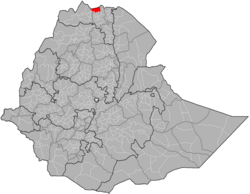Mereb Lehe (Tigrinya: መረብ ለኸ) is a woreda in Tigray Region, Ethiopia. Part of the Maekelay Zone, it is bordered on the south by La'ilay Maychew, on the southwest by Tahtay Maychew, on the west by the Semien Mi'irabawi (North Western) Zone, on the north by the Mareb River (which separates it from Eritrea), on the east by Enticho, and on the southeast by Adwa. The administrative center of this woreda is Rama; other towns include La'ilay Merhisenay.
Mereb Lehe
መረብ ለኸ | |
|---|---|
 | |
 | |
| Country | |
| Region | |
| Zone | Maekelay (Central) |
| Administrative centre | Rama |
| Area | |
• Total | 2,521.70 km2 (973.63 sq mi) |
| Population (2007) | |
• Total | 107,218 |
Demographics
editBased on the 2007 national census conducted by the Central Statistical Agency of Ethiopia (CSA), this woreda has a total population of 107,218, an increase of 37.29% over the 1994 census, of whom 53,425 are men and 53,793 women; 7,911 or 7.38% are urban inhabitants. With an area of 2,521.70 square kilometers, Mereb Lehe has a population density of 42.52, which is less than the Zone average of 56.29 persons per square kilometer. A total of 23,370 households were counted in this woreda, resulting in an average of 4.59 persons to a household, and 22,531 housing units. The majority of the inhabitants said they practiced Ethiopian Orthodox Christianity, with 96.93% reporting that as their religion, while 2.97% of the population were Muslim.[1]
The 1994 national census reported a total population for this woreda of 78,094, of whom 38,906 were men and 39,188 were women; 5,098 or 6.53% of its population were urban dwellers. The largest ethnic group reported in Mereb Lehe was the Tigrayan (99.56%). Tigrinya was spoken as a first language by 99.7%. 98.41% of the population practiced Ethiopian Orthodox Christianity, and 1.55% were Muslim. Concerning education, 9.64% of the population were considered literate, which is less than the Zone average of 14.21%; 10.62% of children aged 7–12 were in primary school; a negligible number of the children aged 13–14 were in junior secondary school, and 0.14% of the inhabitants aged 15–18 were in senior secondary school. Concerning sanitary conditions, about 25% of the urban houses and 6% of all houses had access to safe drinking water at the time of the census; about 6% of the urban and 2.5% of the total had toilet facilities.[2]
Agriculture
editA sample enumeration performed by the CSA in 2001 interviewed 18,660 farmers in this woreda, who held an average of 0.85 hectares of land. Of the 15,776 hectares of private land surveyed, 85.92% was in cultivation, 1.19% pasture, 10.02% fallow, 0.08% woodland, and 2.78% was devoted to other uses. For the land under cultivation in this woreda, 84.12% was planted in cereals, 1.11% in pulses, 0.41% in oilseeds, and 0.15% in vegetables. The area planted in fruit trees was four hectares and two hectares in gesho. 76.55% of the farmers both raised crops and livestock, while 22.23% only grew crops and 1.22% only raised livestock. Land tenure in this woreda is distributed amongst 82.52% owning their land, and 16.68% renting; the amount in other forms of tenure is missing.[3]
2020 woreda reorganisation
editAs of 2020, woreda Mereb Lehe's territory belongs to the following new woredas:[citation needed]
- Chila
- Rama
- Ahsea
Surrounding woredas
editNotes
edit- ^ Census 2007 Tables: Tigray Region Archived 2010-11-14 at the Wayback Machine, Tables 2.1, 2.4, 2.5 and 3.4.
- ^ 1994 Population and Housing Census of Ethiopia: Results for Southern Nations, Nationalities and Peoples' Region, Vol. 1, part 1 Archived 2008-11-19 at the Wayback Machine, Tables 2.1, 2.12, 2.19, 3.5, 3.7, 6.3, 6.11, 6.13 (accessed 30 December 2008)
- ^ "Central Statistical Authority of Ethiopia. Agricultural Sample Survey (AgSE2001). Report on Area and Production - Tigray Region. Version 1.1 - December 2007" Archived 2009-11-14 at the Wayback Machine (accessed 26 January 2009)